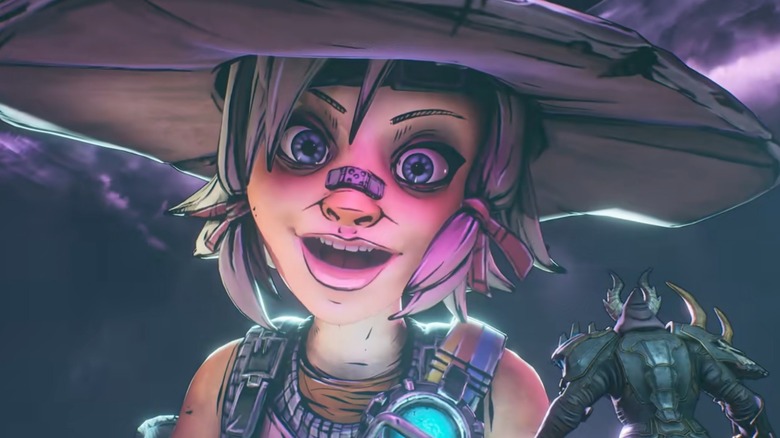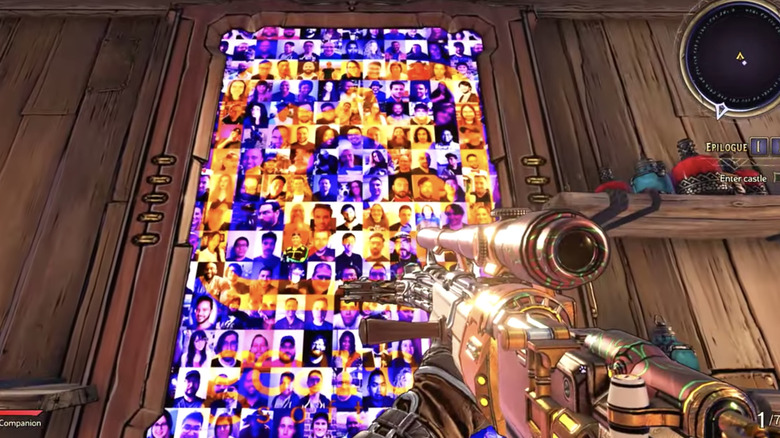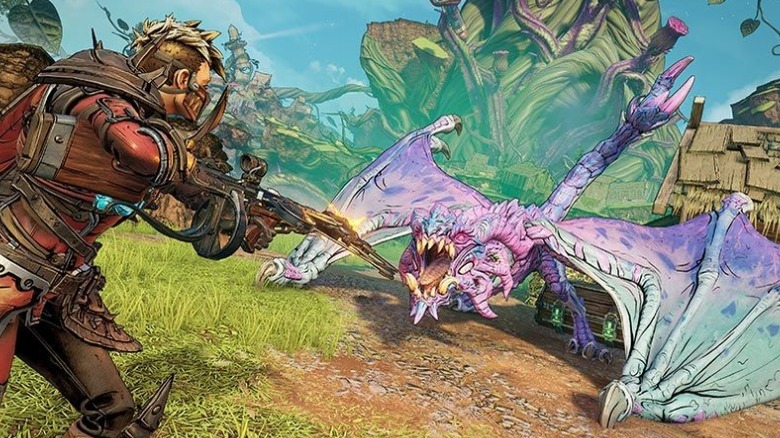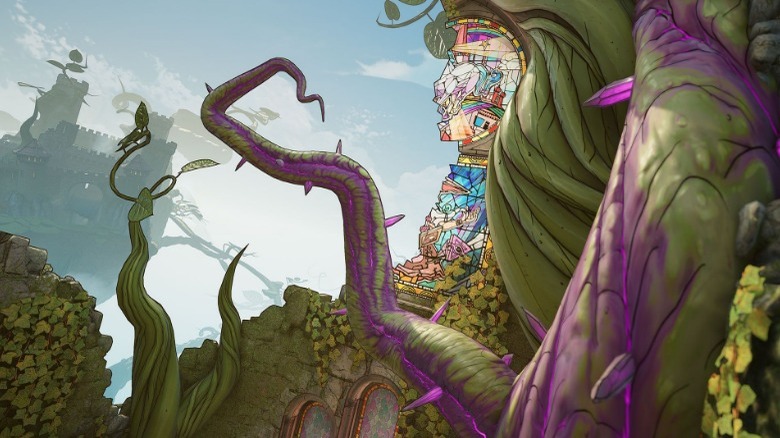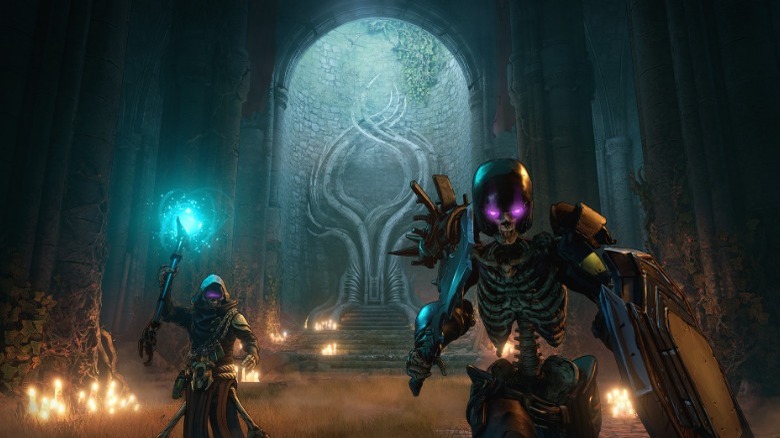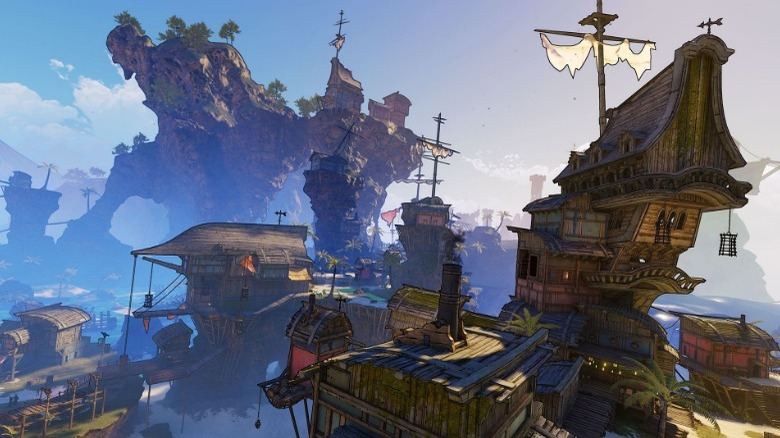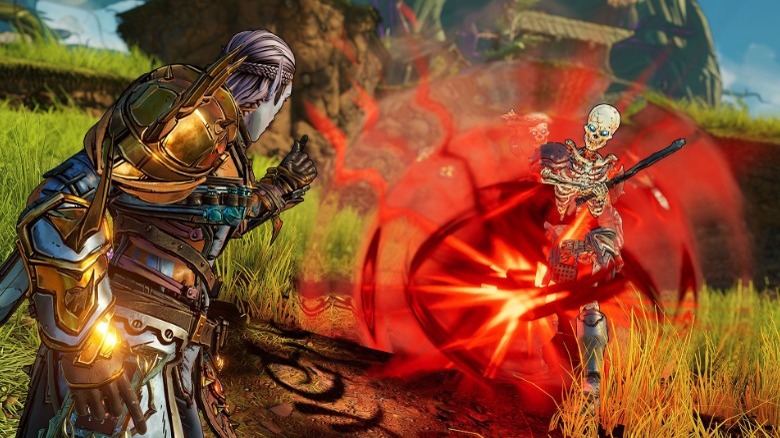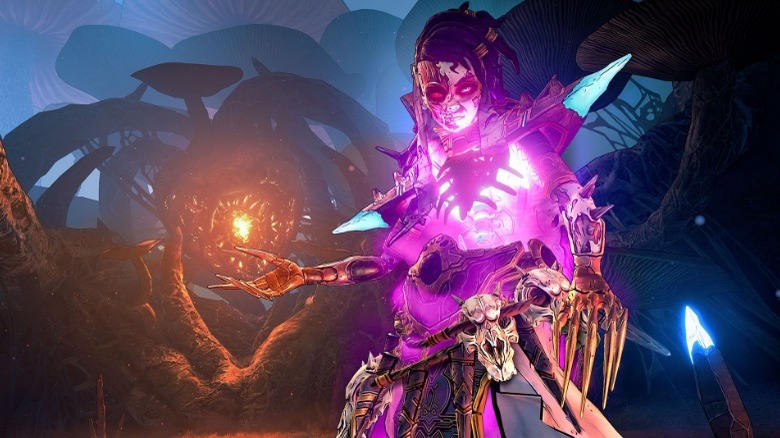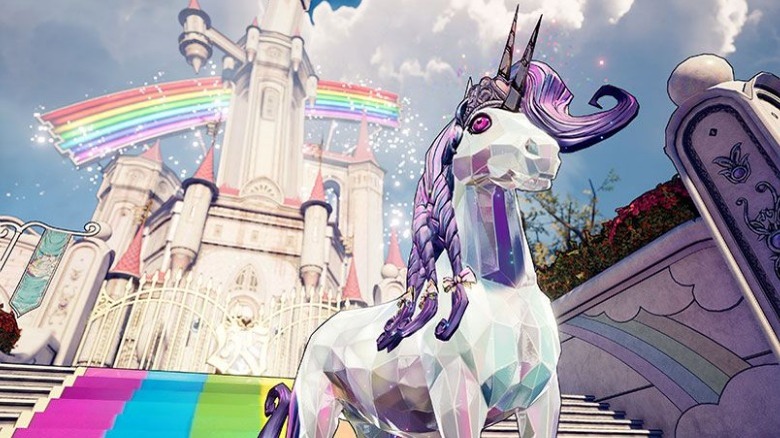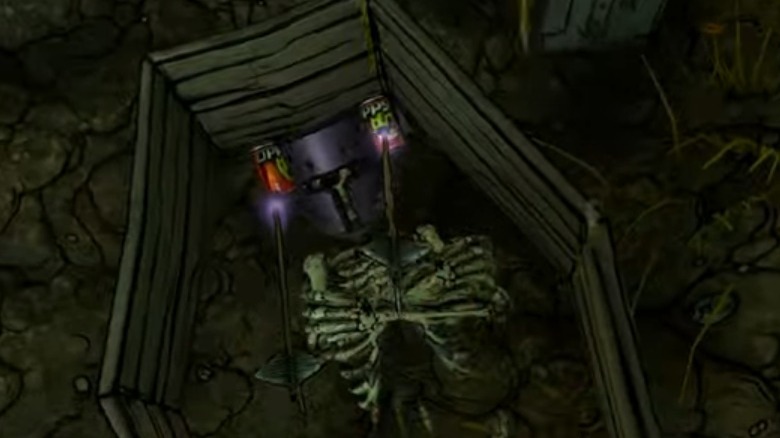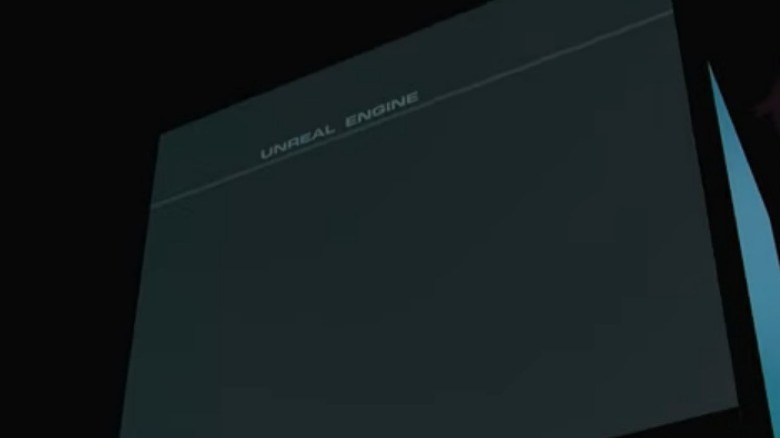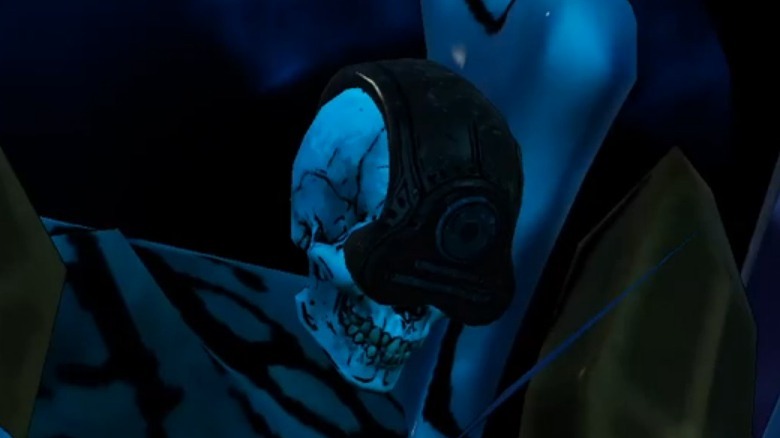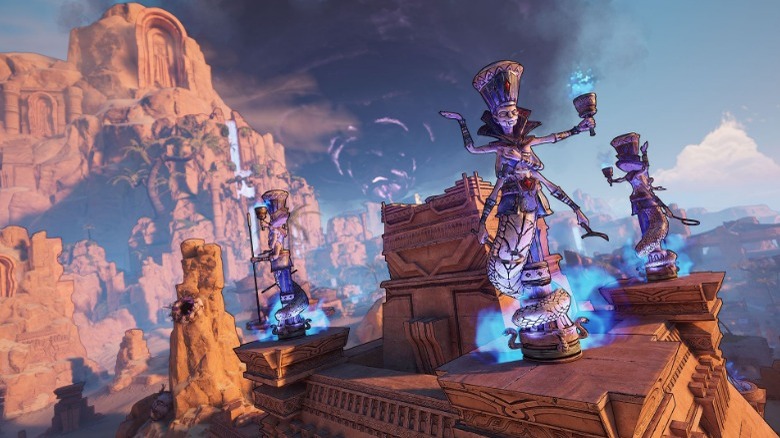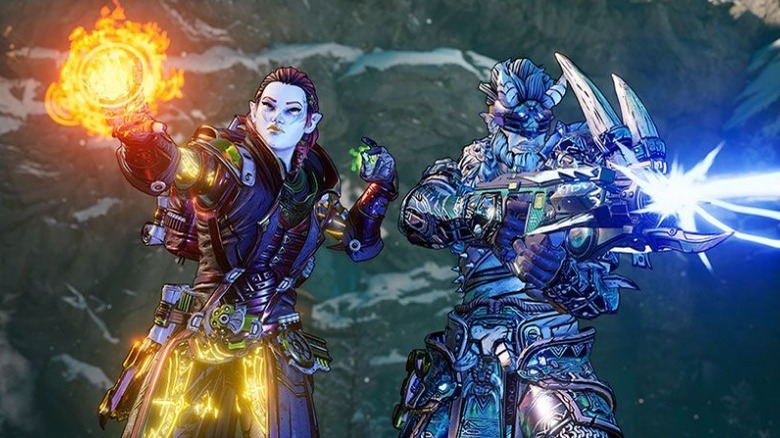Easter Eggs Only True Fans Noticed In Tiny Tina's Wonderlands
The "Borderlands" games have set themselves apart from other looter shooters with a steady diet of comedy. Each entry features a smorgasbord of slapstick, witty banter, and satire. In video games, you can't find a better source of satire than references and Easter eggs.
Past "Borderlands" titles have paid homage to just about every movie, television show, book, video game franchise, and meme under the sun. "Borderlands 2," for instance, includes a hidden "Minecraft" level, complete with Creepers, while "Borderlands 3" features an NPC based on "The Room" director Tommy Wiseau. Since "Tiny Tina's Wonderlands" is a Dungeons & Dragons-themed spinoff of the "Borderlands" franchise, it follows that proud tradition.
"Tiny Tina's Wonderlands" is full of Easter eggs and references that cover the gamut of pop culture, memes, and even Gearbox's own history. Some of these Easter eggs are locked behind difficult barriers, while others hide in plain sight and can only be noticed by devoted fans. Here are some of the more notable ones.
The Developer Room
While some fantastic indie projects have been created by solo developers, the majority of games, especially AAA titles such as "Tiny Tina's Wonderlands," are the product of many coders and designers. The credits section is usually enough to acknowledge these developers and their work, but credits tend to only assign names to contributions. If the team working behind the scenes wants audiences to remember their faces, they need an Easter egg.
"Tiny Tina's Wonderlands" hides a special "developer room" in the main town of Brighthoof, although it isn't really all that well-hidden. To find the room, players need to visit Halker's Walk, which is in the Harborside section of town near the Halker's Walk fast travel site. Once inside the building, gamers should immediately turn left or right to head down the stairs. The basement houses a pretty obvious portal, and the developer's room sits right behind it.
In all honesty, the developer's room isn't all that impressive. A few chests litter the area, and a decently sized poster that features a collage of developer portraits hangs behind a desk, but that's about it. Once players have admired the poster and looted the chests, there's nothing left to do in the room. Plus, the game doesn't exactly incentivize return visits.
The developer room in "Tiny Tina's Wonderlands" might not be as lavish as similar chambers in other games, but at least audiences don't have to jump through obscure hoops to find it, either.
Referencing Rival Games
Even though the console war rages on, many game studios maintain a friendly rivalry with one another. Sometimes, developers reference and rib titles produced by other studios, and "Tiny Tina's Wonderlands" is one of them.
Several characters and enemies in "Tiny Tina's Wonderlands" are obvious pastiches of popular characters and mobs from other games. For instance, Gerrit of Trivia is clearly a parody of Geralt of Rivia from the "Witcher" series. Meanwhile, the skeletons Bones Three-Wood and Chartreuse LeChance are unmistakably inspired by Guybrush Threepwood and LeChuck from LucasArts' "Monkey Island" series. And during the mission Spell to Pay, players encounter unique wyvern enemies called "Wyrthian" and "Azure Wyvern," which are more than likely nods to the Rathian and Azure Rathalos enemies from "Monster Hunter."
Several video game Easter eggs in "Tiny Tina's Wonderlands" are slightly more up in the air. For instance, the Frying Pan weapon deflects most bullets, which may or may not refer to the unintentional bulletproof nature of frying pans in "PUBG." Also, in order to encounter random enemies in the overworld of "Tiny Tina's Wonderlands," players need to walk through tall grass, a design that might crib from (and rib) the "Pokemon" franchise, specifically how players encounter wild battles by walking in tall grass.
On a side note, did you know you can kill mushroom enemies in "Wonderlands" by stomping on them? It's true. Not only is that an efficient way to defeat a common creature, but it also likely references the preferred method of fighting Goombas in "Super Mario" — Goombas are evil fungi, after all.
Literary References
Many video games draw from literature. The "Witcher" and "Metro" franchises, for example, are actually adaptations of popular novels. "Tiny Tina's Wonderlands" also borrows from famous stories, if only to populate the game world with Easter eggs.
Like other references in the "Borderlands" franchise, literary Easter eggs in "Tiny Tina's Wonderlands" come in different sizes and flavors. Some are just enemies named after popular literary characters (or villains), including the likes of Mobley Dick, Biter of Crews, Scourge of Salt and Sand. Another blink-and-you'll-miss it Easter egg is the legendary pistol Gluttony. This weapon restores its owner's health by damaging enemies, so the name fits. But what makes it a book reference? The item's description reads "Equivalent exchange," which makes the gun an obvious allusion to the manga "Fullmetal Alchemist," in which Gluttony is one of its primary antagonists. However, many literary Easter eggs are big enough to fill a chapter in the game's design document.
One of the most obvious story-themed references is the area of Tangledrift, which is a blatant allusion to the story of "Jack and the Beanstalk." Meanwhile, the quest "A Knight's Toil" references everything King Arthur. The mission revolves around the sword Extra-Caliber (a play on King Arthur's sword Excalibur), the wizard Mervin (a parody of Merlin) and King Archer (that reference should be obvious). If that's not enough, the quest even crosses the streams and adds a "The Lord of the Rings" reference in which Claptrap needs to "Speak friend and enter."
There are probably plenty of other references, so keep a lookout for more bookish Easter eggs.
Past Gearbox Games
Audiences love a good callback. The more games a studio develops, the more titles its game designers can reference in future projects. "Tiny Tina's Wonderlands" references several other games with Gearbox's fingerprints.
"Tiny Tina's Wonderlands" takes place in the "fantasy" in-universe game of Bunkers and Badasses, which first appeared as "Borderlands 2" DLC "Tiny Tina's Assault on Dragon Keep." It stands to reason that "Wonderlands" leans heavily on events and characters from the main "Borderlands 2" story and its mini-expansion. For instance, Mr. Torgue wanted to blow up the ocean in "Assault on Dragon Keep." In "Tiny Tina's Wonderlands," he finally gets his wish via a "magic" missile. He even sneaks in a "need more cowbell" reference while doing so. The game's main antagonist also delivers an Easter egg by name-dropping (kinda) the franchise's most famous villain, Handsome Jack.
Now, "Borderlands 2" doesn't hog all the callbacks. Anyone who looks at the "magic" missile silos after Mr. Torgue declares nuclear armageddon on the ocean should notice they sport the universal symbol for radiation. While this is fitting, it also more than likely references Duke Nukem, as Gearbox also owns the rights to that character.
However, the award for most subtle reference has to go to the legendary Shadowfire SMG. Whenever players reload this weapon, they toss it like a grenade, and it explodes into a pillar of hellfire surrounded by spiked rings. This effect probably doesn't look familiar unless you played Gearbox's failed hero shooter "Battleborn." One of that game's playable heroes, Orendi (who shares the same voice actor as Tiny Tina), can summon a giant pillar of hellfire surrounded by spiked rings. The name of this attack? Shadowfire Pillar.
Movie References
Movies are full of memorable quotes. Who doesn't love reciting lines from "The Princess Bride" or "The Godfather?" Like many games with satirical flair, "Tiny Tina's Wonderlands" homages many movie moments while also making fun of them.
As is tradition in many video games, "Tiny Tina's Wonderlands" heaps on references to the arguable king of sci-fi franchises, "Star Wars." For instance, the Maced Wardu item is a glaringly obvious reference to the character Mace Windu not only in name but in flavor text, since it copies his famous last words: "He's too dangerous to be left alive." Also, the "Borderlands" punching bag Claptrap paraphrases Anakin Skywalker's infamous opinion of sand. Most surprising of all, in the quest Little Boys Blue, the character Garglesnot — a pastiche of "Smurfs" villain Gargamel — rattles off several slightly altered "Star Wars" quotes in quick succession.
Some other films receive Easter egg love in "Tiny Tina's Wonderlands." If players mess up the mushroom hopping segment several times in "A Knight's Toil," Claptrap offers his own take on Alfred's "Why do we fall" quote from "The Dark Knight" series. The game also references "Pirates of the Caribbean" by giving one pirate enemy the name "Captain Swallow" (an obvious take on Captain Sparrow).
However, one of the most confusing Easter eggs is the quest "Raiders of the Lost Shark." At first glance you might assume it is a simple nod to the classic film "Raiders of the Lost Ark," but there's also an extremely obscure movie also titled "Raiders of the Lost Shark." Not only that, but "Raiders of the Lost Shark" is also the name of an episode from the "Aladdin" animated series. So which does the mission reference? Not even Tiny Tina knows.
Random Character Quotes
The "Borderlands" franchise includes countless lines and quips that give each NPC, playable character, and humanoid enemy a unique personality. While these quotes are usually applicable to the situation — even the normally-unintelligible Psycho enemies occasionally experience some situational lucidity — some are references and Easter eggs.
Since the characters and enemies in "Tiny Tina's Wonderlands" are part of Tiny Tina's wild imagination (the adventure is technically an in-universe D&D campaign with guns), many quips follow her own quirky sense of humor. That means jokes and references every five minutes — or more, depending on how quickly you kill enemies. For example, every time a skeleton dies (don't ask), it might say, "They said I'd get to ride a spider." The mere concept of skeletons riding giant spiders sounds cool and hilarious, but it's also a reference to "Minecraft," since skeletons in that game sometimes ride giant spiders into battle.
Enemies aren't the only characters who articulate Easter eggs, though; the playable character has quite a few referential quotes of their own. They might occasionally say, "Behold, my stuff!", which is a direct line from "Thor: Ragnarok." However, the protagonist also has different quotes depending on their class. Case in point, when using Clawbringer skills, the protagonist can say, "Ride the lightning" (a song and album by Metallica) or "Praise the sun" (a "Dark Souls" quote/meme).
"Tiny Tina's Wonderlands" has many more Easter eggs hiding in character quotes, but if we went through all of them, we would probably be here all day.
Special Bosses
While many Easter eggs in the "Borderlands" franchise also serve double duty as references, some are bonafide secrets that players need to uncover. One such Easter egg is a collection of endgame bosses.
As gamers make their way through the endgame Chaos Chamber, they might uncover special runes. By interacting with these symbols, players reveal hidden puzzles that, when solved, unlock super-secret raid bosses who integrate the puzzles into their fights. There are three runes in total and three associated bosses: Gloopathoth, Keeper of the Abyss; Bunnidhogg, Keeper of the Sands; and Barkenstein, Keeper of Nature. Quite appropriately, these battles feel like the kinds of raid bosses you'd find in a fantasy MMO. Once they're dead, you might think that's all the secret bosses "Tiny Tina's Wonderlands" has to offer. Not quite.
During each battle, players are contacted by a spectral version of Tiny Tina, dubbed "The Maker." She isn't just there for show, either; The Maker is also the fourth and final secret raid boss, and she is an absolute nightmare to find. In order to confront The Maker, players have to beat Gloopathoth, Bunnidhogg, and Barkenstein in one Chaos Chamber run. That is as challenging as it sounds.
Anyone who manages to defeat The Maker should pat themselves on the back, since they have completed the ultimate gun-fueled gauntlet "Tiny Tina's Wonderlands" has — at least for now.
Musical References
For the most part, "Tiny Tina's Wonderlands" wears many of its references on its sleeves and literally spells out its Easter eggs. However, some only reveal themselves to gamers with an ear for music.
If players visit the reroll station in Brighthoof, they should find some self-hammering hammers. At first glance, these mallets sound like they're pounding randomly, but anyone who listens carefully might recognize a few familiar rhythms. One tune should be obvious to anyone who used to be a little child, since it's "Mary Had a Little Lamb," but the others are a little more confusing. For all we know, the other "songs" are just random poundings and not songs at all.
Another referential song pops up during the quest "Ballad of Bones." During the mission, players have to venture through a tunnel, and the titular Bones starts belting out a strangely familiar ballad at the entrance. Given the sheer number of skeleton pirates and the trolley tracks in the tunnel, one might immediately jump to the Disney classic "Yo, Ho! (A Pirate's Life For Me)." However, the song is actually a heavily modified take on Nathan Evans' "Wellerman" shanty.
With any luck, "Tiny Tina's Wonderlands" will add even more musical memes in future updates.
TV Show Easter Eggs
Since "Tiny Tina's Wonderlands" Easter eggs reference video games and movies, it only makes sense to include tv show references and complete the visual entertainment medium trifecta.
Like some other Easter eggs, the biggest TV references in "Tiny Tina's Wonderlands" take up entire quests. The mission "Little Boys Blue" is a prime example, as it is one great big "Smurfs" reference. Every friendly quest NPC is a pastiche of a Smurf, dubbed "Murphs" here. Like their source material, they replace random verbs, adverbs, and adjectives with the word "murph." Granted, the Smurf stand-ins are all green and their blue counterparts are actually rage-fueled zombies — but hey, if you can't stand the Smurfs, you get to take out a bunch of the little blue creatures.
If you are in the mood for a TV-themed Easter egg you have to really search for, though, "Tiny Tina's Wonderlands" has you covered. Anyone who scours the cemetery in Shattergrave Barrow should find a recently exhumed casket containing a skeleton wearing a suspiciously familiar helmet. Two soda cans on the side seem to turn the helmet into a "SpongeBob SquarePants" reference, specifically the #1 drinking hat of Smitty Werben Man Jensen.
These are only some of the most notable TV references in the game. The sheer number of analogues and allusions would melt your brain if we listed them all.
Unreal Engine
A game engine can make or break an experience. EA's proprietary Frostbite engine is infamous for causing problems in every game that isn't a first-person shooter (case in point, "Mass Effect: Andromeda"), but the Unreal Engine is a veritable genre chameleon. Developers have used the toolset to create sports games such as "Tony Hawk's Pro Skater 1 + 2," RPGs like "Dragon Quest XI," and every "Borderlands" title. It was only a matter of time until Gearbox paid it forward.
During the quest "A Knight's Toil," the player gets trapped in a cage, and it's up to Claptrap to rescue them. In typical Claptrap fashion, he screws up. Well, he manages to teleport the player out of the cage, but Claptrap accidentally sends them to the "Fabled Gray Plains of the Nonreal." The Nonreal is an obvious allusion to the Unreal engine given the simple geometry, grid floor, and an x-y-z axis indicator. These are some of the first things any game developer sees while using the Unreal Engine — or any modern 3D game engine for that matter. Oh, and the giant box that reads "Unreal Engine" is also a solid hint.
Ultimately, this Unreal Engine Easter egg exists because Claptrap is so bad at writing D&D campaigns that his ineptitude breaks all suspension of disbelief and the game engine. Par for the course when it comes to Claptrap and his plans, if we're being honest, but welcome nonetheless.
Hiding Something
Video game Easter eggs are usually in hidden locations that aren't easy to find, but still accessible through regular means. However, every now and then developers hide secrets behind impassable walls, inside props, and in other locations people would never see during normal gameplay. The more nonsensical the secret and its hiding spot, the better.
During "A Knight's Toil" — which might as well be Easter egg central given how many times it has cropped up — players have to pass several tests to earn a special reward. One test involves determining which Mervin the Wizard is real. Claptrap thinks he knows which one is genuine, his logic being that particular Mervin looks smug, as if he's hiding something. Spoiler alert: Claptrap picks the wrong Mervin, but he didn't know how right he was about the wizard "hiding something."
Reddit user Rxmzi discovered that Mervin is indeed hiding something, but most players wouldn't know that unless they abused the game's photo mode. Rxmzi demonstrated that if you take the photo mode's camera and use it to clip through Mervin's head, a smaller skull wearing a weird VR helmet-like device floats inside.
Why does Mervin's skull house a smaller skull? No idea. It's not like he lobs them at players as if they were Lost Souls from "Doom." Then again, the game industry is full of assets and models that house strange additions just out of reach of the normal camera; Mervin is just the latest in that ever-growing list.
Not Again, Karen!
Karens have swiftly become the punching bag of society. Karens, the meme goes, aren't necessarily anyone named Karen, but rather men and women who think they are above the law and entitled to literally anything they want because — well, they never can explain why. More and more games and shows have featured Karens getting their comeuppance, and "Tiny Tina's Wonderlands" takes that to an extreme.
During the quest "Gumbo No. 5" (its name another musical reference), players need to retrieve several ingredients for a love potion, the first of which is crab legs. Gamers can either steal or buy the item from a merchant. If players try to rob the crab leg vendor, she attacks, so purchasing the ingredient legitimately should be the way to go, right? Not if a Karen has anything to say about it.
If players buy the crab legs, they don't get five feet away before a wild Karen (literally named Karen) shows up and demands them for herself. And yes, she does attack the main character. Her attempt goes as well as you might expect, and the crab leg merchant sheds a few crocodile tears for her before going back to work.
Item Descriptions
Many items in video games, including RPGs, include flavor text that give them a little more pizazz. For the most part, these offer no mechanical in-game advantages and reading them is completely optional, but some titles include important nuggets in them. Players who ignore these bits of text do so at their own peril, as "Tiny Tina's Wonderlands" hides many of its Easter eggs in these tiny blurbs.
Item Easter eggs cover the whole spectrum of sources, but most reference other video games. For instance, the Corrupted Platemail armor includes the sentence, "There must always be a Leech King," while the Twin Soul sword's flavor text reads, "A hero desires a sword, and a sword desires truth." The former is a play on the "World of Warcraft" line "There must always be a Lich King," while the latter is a direct quote from "Soulcalibur." Plus, Twin Soul kinda looks like the Soul Calibur weapon, so the flavor text fits.
Since item description Easter eggs are somewhat limited due character restrictions, many just reference general memes. One prominent example is the Smart Armor, which reads, "Task critically failed successfully," an obvious play on the meme-worthy "Task failed successfully" PC error message. Meanwhile, the Shell Casing Ring's flavor text states, "Stop habitually reloading." This Easter egg isn't a direct quote or anything, but rather a playful jab at the bad habit of gamers to reload in-game guns after firing a single shot.
"Tiny Tina's Wonderlands" is full of weapons, so there are more flavor text memes and references than we could ever fit in this article. And of course, the number of item description Easter eggs will only increase when Gearbox inevitably adds new weapons.

